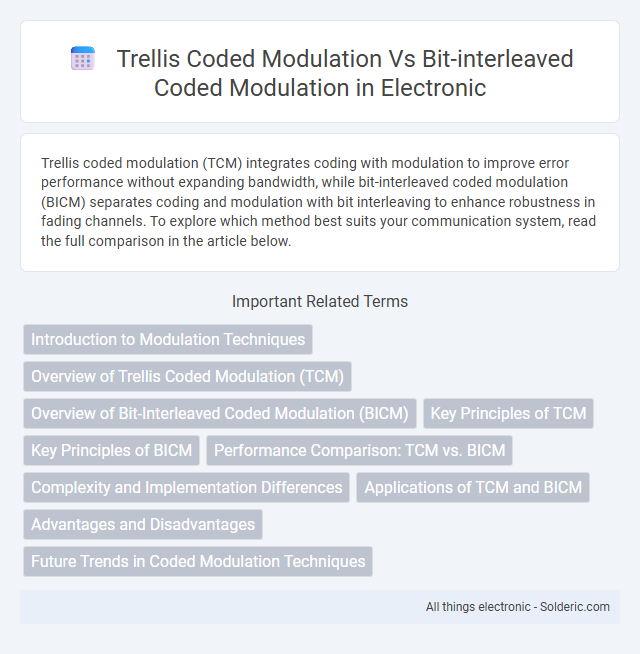Trellis coded modulation (TCM) integrates coding with modulation to improve error performance without expanding bandwidth, while bit-interleaved coded modulation (BICM) separates coding and modulation with bit interleaving to enhance robustness in fading channels. To explore which method best suits your communication system, read the full comparison in the article below.
Comparison Table
| Feature | Trellis Coded Modulation (TCM) | Bit-Interleaved Coded Modulation (BICM) |
|---|---|---|
| Concept | Combines convolutional coding with signal modulation using set partitioning | Combines binary channel coding with bit interleaving and modulation |
| Error Performance | Optimized for AWGN channels with strong coding gain | Robust across fading and multipath channels |
| Design Complexity | Complex encoder and decoder; requires joint design of code and modulation | Simpler receiver design; separates coding and modulation |
| Interleaving | Usually no interleaving; uses set-partitioned modulation | Uses bit-level interleaving to improve diversity |
| Application | High data rate systems with AWGN channel assumptions | Wireless communications with fading channels (e.g. LTE, Wi-Fi) |
| Decoding | Maximum likelihood sequence decoding (Viterbi) | Bit-wise decoding with iterative detection and decoding possible |
| Flexibility | Less flexible; dependent on specific constellation partitioning | Highly flexible; supports variable code rates and modulation formats |
Introduction to Modulation Techniques
Trellis Coded Modulation (TCM) integrates convolutional coding with modulation to improve error performance without increasing bandwidth, making it highly efficient for digital communication. Bit-Interleaved Coded Modulation (BICM) separates coding and modulation processes, employing bit interleaving to enhance performance over fading channels by increasing diversity. Your choice between TCM and BICM depends on system complexity, channel conditions, and desired error resilience.
Overview of Trellis Coded Modulation (TCM)
Trellis Coded Modulation (TCM) combines convolutional coding with higher-order modulation schemes to improve error performance without increasing bandwidth. It utilizes a trellis structure to encode data, introducing redundancy that enables the receiver to correct errors effectively while maintaining spectral efficiency. TCM is widely applied in digital communication systems such as modems and wireless networks, delivering enhanced reliability in noisy channels.
Overview of Bit-Interleaved Coded Modulation (BICM)
Bit-Interleaved Coded Modulation (BICM) enhances communication reliability by combining channel coding with bit-level interleaving before modulation, which helps mitigate burst errors in fading channels. Unlike Trellis Coded Modulation (TCM) that integrates coding and modulation into a single process using trellis structures, BICM separates coding and modulation, allowing for more flexible code and modulation design. BICM is widely used in wireless systems due to its robustness in multipath fading environments and its compatibility with various modulation schemes like QAM and PSK.
Key Principles of TCM
Trellis Coded Modulation (TCM) combines convolutional coding with multi-level modulation schemes to improve error performance without increasing bandwidth, utilizing set partitioning and expanded signal constellations for effective coding gain. It encodes information bits into higher-dimensional signal points, exploiting the Euclidean distance to maximize minimum distance between coded symbols. The trellis structure enables sequence-based decoding methods like the Viterbi algorithm, enhancing error correction while maintaining spectral efficiency.
Key Principles of BICM
Bit-Interleaved Coded Modulation (BICM) enhances communication reliability by combining channel coding and modulation with bit-level interleaving, which mitigates error bursts in fading channels. This key principle allows BICM to offer improved performance over Trellis Coded Modulation (TCM) by independently optimizing the coding and modulation schemes while maintaining flexibility. Your system benefits from BICM's robustness in varying channel conditions, making it suitable for modern wireless communication standards.
Performance Comparison: TCM vs. BICM
Trellis Coded Modulation (TCM) typically offers better coding gain and error performance in AWGN channels due to its integrated use of convolutional codes with modulation. Bit-Interleaved Coded Modulation (BICM) provides greater flexibility and robustness in fading environments by combining coding and modulation with bit-level interleaving, improving diversity. Your choice between TCM and BICM should consider the communication channel characteristics and system complexity requirements for optimal performance.
Complexity and Implementation Differences
Trellis Coded Modulation (TCM) integrates convolutional encoding with signal modulation, requiring a trellis-based decoder that increases implementation complexity due to state explosion in higher-order constellations. Bit-Interleaved Coded Modulation (BICM) separates channel coding and modulation, employing simpler bit-wise decoding techniques and interleaving, which reduces complexity and enhances robustness in fading channels. The modular design of BICM allows easier implementation and adaptation across various communication standards compared to the more intricate and computationally intensive TCM.
Applications of TCM and BICM
Trellis Coded Modulation (TCM) is widely applied in digital subscriber lines (DSL) and satellite communications where bandwidth efficiency and error performance are crucial. Bit-Interleaved Coded Modulation (BICM) finds extensive use in wireless communication systems like LTE and Wi-Fi due to its robustness against fading and ease of implementation with bitwise decoding. Your choice between TCM and BICM depends on the specific channel conditions and system complexity requirements.
Advantages and Disadvantages
Trellis coded modulation (TCM) offers improved error performance by combining convolutional coding with modulation, which enhances bandwidth efficiency without increasing signal power; however, it requires complex decoding algorithms and is less adaptable to varying channel conditions. Bit-interleaved coded modulation (BICM) provides greater flexibility and robustness in fading channels by interleaving coded bits before modulation, facilitating simpler decoding and compatibility with modern iterative decoding techniques, but it may suffer from a performance loss compared to TCM in additive white Gaussian noise (AWGN) channels. The choice between TCM and BICM depends on the trade-off between decoding complexity, channel conditions, and performance requirements.
Future Trends in Coded Modulation Techniques
Future trends in coded modulation techniques emphasize combining high spectral efficiency with robust error correction, where bit-interleaved coded modulation (BICM) is evolving to support flexible coding rates and modulation schemes for 5G and beyond. Trellis coded modulation (TCM) remains relevant in scenarios demanding low latency and complexity, especially in optical and satellite communications. Your choice between TCM and BICM will increasingly depend on the specific application's requirements for throughput, latency, and hardware implementation complexity.
trellis coded modulation vs bit-interleaved coded modulation Infographic

 solderic.com
solderic.com